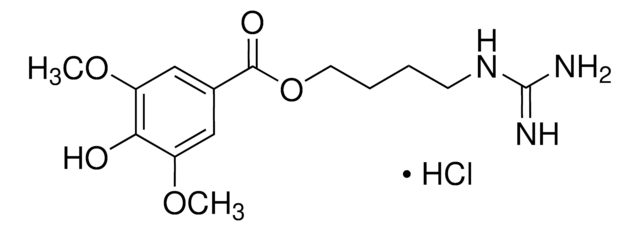SBR00029
Dansyl labeled polymyxin B Ready Made Solution
for fluorescent microbial imaging, 1.5 mg/mL in H2O
Sinónimos:
DSL-PMB, DSL-PMX, DSL-PxB
About This Item
Productos recomendados
Quality Level
form
solution
availability
not available in China
concentration
1.5 mg/mL in H2O
color
colorless to light brown
suitability
suitable for (Fluorescent detection of gram-negative bacteria)
suitable for (Microbiome)
suitable for microbiology
mode of action
cell membrane
shipped in
ambient
storage temp.
−20°C
General description
Application
- as a fluorescent probe to study polymyxin mode of action and its pharmacokinetics
- in research and to develop new active derivatives of Polymyxin against multi-drug resistance Gram-negative infections
- to measure LPS binding affinity by fluorometric displacement assay
- Antimicrobial resistance research.
- Bacterial visualization and imaging.
- Parent antibiotic mode of action research and new antibiotic discovery.
- Toxicity studies.
- Research of bacterial infections and tracking its uptake in vivo.
Biochem/physiol Actions
Features and Benefits
- High-quality antibiotic suitable for multiple research applications
- Ideal for Cell Biology, Metabolomics, and Biochemical research.
Analysis Note
- Dansyl Labeled Polymyxin B Ready Made Solution is light sensitive.
- It is recommended to avoid freeze-thaw cycles of PMB-DSL Ready Made Solution.
- Dansyl Labeled Polymyxin B Ready Made Solution (1.5 mg/mL) can be diluted 1:50 in PBSX1 (Sigma#D8537) to achieve 30 μg/mL final concentration for staining. The above concentration of DSL-PMB was used for E. coli staining see image.
- Fluorescence Microscopy application: Dansyl Labeled Polymyxin B Ready Made Solution excitation (Ex) wavelength is 330-340nm resulting in emission (Em) range of 540-600nm (λmax=570nm).
Other Notes
Storage Class
12 - Non Combustible Liquids
wgk_germany
WGK 1
flash_point_f
Not applicable
flash_point_c
Not applicable
Choose from one of the most recent versions:
Certificados de análisis (COA)
Don't see the Right Version?
If you require a particular version, you can look up a specific certificate by the Lot or Batch number.
¿Ya tiene este producto?
Encuentre la documentación para los productos que ha comprado recientemente en la Biblioteca de documentos.
Nuestro equipo de científicos tiene experiencia en todas las áreas de investigación: Ciencias de la vida, Ciencia de los materiales, Síntesis química, Cromatografía, Analítica y muchas otras.
Póngase en contacto con el Servicio técnico






